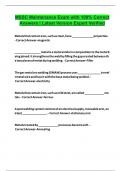Samenvatting
Summary Articles, Lectures & Knowledge clips Strategic Human Resource Management
- Instelling
- Tilburg University (UVT)
Summary of all the articles, lectures & knowledge clips of Strategic Human Resource Management. Theme 1 - Black Box Debate - Knowledge clip - Lecture - Peccei, R. & van de Voorde, K. (2014). HRM and performance. In: Encyclopaedia of Human Resource Management. Guest, D. & Needle, D. (Eds). Chichest...
[Meer zien]













